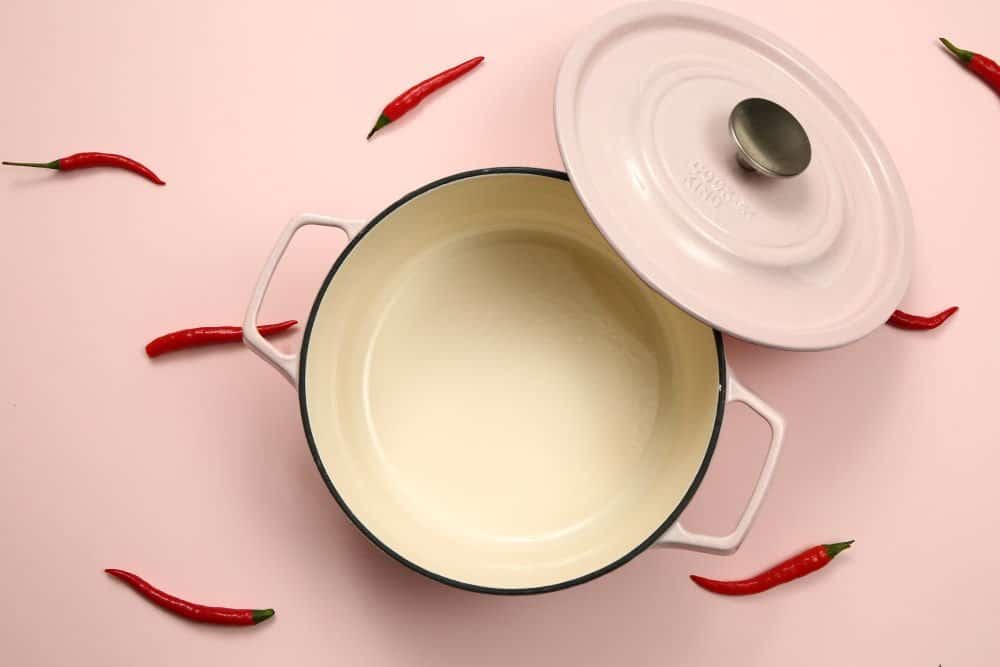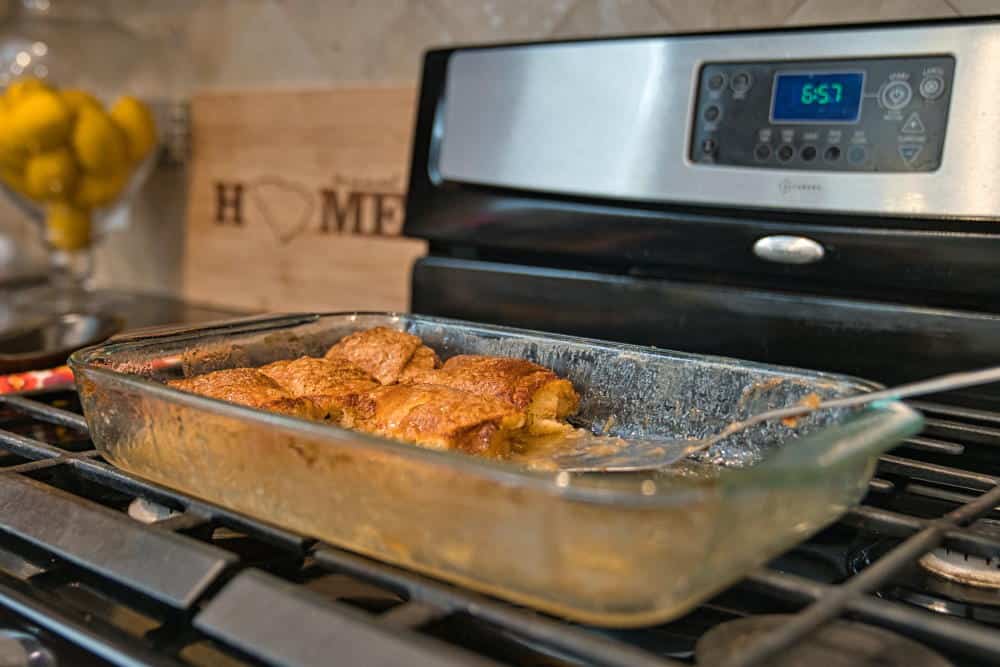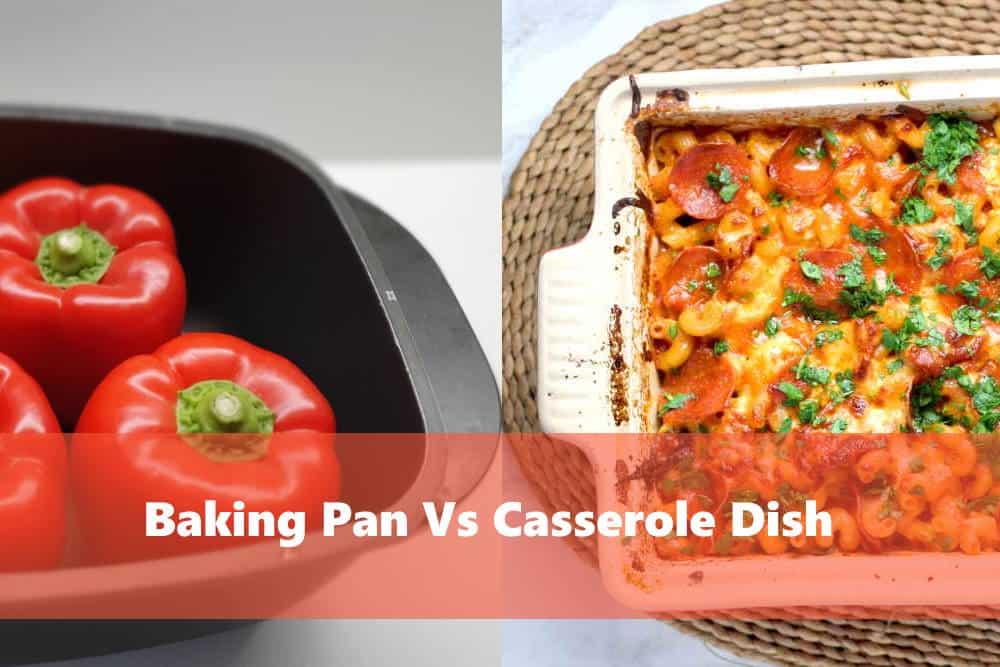Debating on baking pan vs casserole dish – trying to figure out what’s better for what you need to cook? You’re in the right place.
Just like baking pie is a lot different from making mac and cheese, baking pans are also different from casserole dishes. While it’s easy to find the right ware when you’re in the kitchen, things get a lot more complicated when you’re looking to buy one of these wares.
Between different materials, sizes, and coatings, you must also factor in the risk of burning your dish and the time it’ll take to cook with the ware. Plus, baking pans and casserole dishes aren’t always interchangeable.
But, there’s no need to feel swamped.
I’ve extensively compared baking pans and casserole dishes for you. I will guide you through what you should be using to cook which dish, and what key considerations you must factor in when buying a baking pan or a casserole dish.
Baking pan vs casserole dish: things you should know before buying
Materials
Baking pans
You’d think aluminum baking pans are the only metal bakeware available. However, carbon steel baking pans have become common in kitchens the world over in recent years.
Carbon steel baking pans are typically cheaper and more durable than aluminum baking dishes.
These come with the easy-to-recognize dark non-stick coating, but in recent times, some brands have begun to switch it up and offer champagne gold baking pans.
Stainless steel pans don’t offer much benefit, and since carbon steel pans are similarly priced, buying them is out of the question.
Casserole dishes

You have a TON of options in terms of materials when getting a casserole dish. Pyrex, ceramic, stoneware, and porcelain are only some of your many options.
Ceramic casserole dishes are typically favored over other dishes since they have enticing and colorful designs, can be put away in the fridge after a meal, are microwave- and dishwasher-safe, and fairly easy to clean.
However, casseroles typically do not come with non-stick coatings.
Enameled cast iron casseroles, which are also called dutch ovens, are another chef-favorite because of the flexibility they supply.
You can start your cooking on the stovetop, finish in the oven, serve on the table, and refrigerate the leftovers with an enameled cast-iron casserole.
But these also tend to be more expensive and typically aren’t microwave-safe, which is important to note.
Ease of use (oven-to-table and beyond)
Baking pans
Baking pans do not come with lids, so you can’t throw on a lid and put the Lasagna away after you’re full.
Casserole dishes
Most casserole dishes come with lids, and since they look good and are safe to have on a table, your pasta can go right to the table from the oven and into the fridge later.
No fuss!
Heat resistance and cooking time
Baking pans
Some Aluminum baking pans have a lower heat resistance of 450°F (500°F heat resistance is now the norm). However, this shouldn’t make a difference to most home cooks.
If you’re an inexperienced cook, Aluminum baking dishes may be right for you, since you don’t have to adjust the baking temperature and work with a variable baking time like you have to with some other materials.
You can just follow the cookbook or video to a T!
Most carbon steel baking pans also have a relatively lower heat resistance of 450°F. However, these pans heat up more than Aluminum pans, and can easily burn your food.
Top chefs recommend that if you’re using a carbon steel pan, you must lower your oven’s temperature by 25°F than what’s recommended in the recipe.
You may also need to get your dish out of the oven up to 10 minutes earlier than estimated, depending on what you’re cooking. It’s best to be around the oven and keep a close eye on your dish towards the end of the cooking time.
Casserole dishes
Glass casserole dishes (specifically Pyrex) also have the same pitfalls as carbon steel baking pans – they heat up hotter, and you will need to turn your oven down as advised.
Some chefs also recommend that you don’t use glass and ceramic casserole dishes in recipes that require heating above 425°F at all.
In a lot of cases, the dishes shattered inside the oven – and that’s a mess no one wants to deal with.
Durability
Baking pans
Some Aluminum baking pans aren’t dishwasher safe, and not having that flexibility can make clean-up a lot more difficult than it should be.
If you don’t deal with the grease build-up, the pan will only last you for a few years.
Carbon steel baking pans, on the other hand, are not only dishwasher-safe but also come with a non-stick coating, which extends the life of the pan.
Casserole dishes
If you’re using glassware, such as Pyrex, you have to remember not to put it in the fridge right after it comes out of the oven.
Glassware is prone to breaking from thermal shock – a rapid change in temperature could cause the dish to shatter.
You must allow Pyrex to cool down to room temperature before you put it in the fridge.
Enameled cast-iron casserole dishes are very durable and last forever. As long as you can work with the drawback of not meaning able to microwave it, getting a dutch oven is worth every penny for long term use.
Purpose (when to use which bakeware)

Baking pans
This will sound a little obvious, but baking pans are good for baking.
Both Aluminum and carbon steel pans are lightweight, conduct heat evenly, and deliver a lovely tender crust.
But there’s a lot more you can do with baking pans. They’re great for broiling, grilling, and roasting meat.
Since broiling is done at high temperatures, comparatively delicate casseroles just can’t pull off the same effect.
On the same note, baking pans (both stick and non-stick) are also great for roasting vegetables.
Casserole dishes
While it’s common knowledge that casseroles and pastas are prepared in casserole dishes, you can also use these baking dishes to make fruit-based desserts like cobblers and pies.
Dutch ovens are excellent metal pans and are often used for braising – which is one of the best ways to make meat soft, juicy, and flavorful.
Baking pan vs casserole dishe: frequently asked questions
Q: Can you use a baking pan instead of a casserole dish?
A: For making pasta, to a point, yes.
However, you must proceed carefully since metal (both the stick and non-stick variety) reacts with acidic foods like tomato sauces and some fruit dishes like pies.
The reaction causes the metal baking pan to warp and develop hot spots. But these effects are not immediate, and only occur if you abuse the pan a lot over time.
If you want to make mac and cheese in a baking pan, go ahead. You could also use metal baking pans for making the occasional arrabbiata pasta if your trusted casserole is in the dishwasher.
Q: Can you bake a cake in a casserole dish?
A: Yes, you can safely bake a cake in a casserole dish.
If you’re using Pyrex, though, you must remember to grease the dish well and pre-heat and bake at 25°F lower than advised, else the cake will come out over-baked and have a tougher crumb.
Also, towards the end of the baking time, you must keep a close eye on your cake, because casserole dishes bake at a faster rate even when the temperature is lower.
The rules are a little different for ceramic. Let’s talk about those.
Unlike Pyrex, ceramic absorbs heat at a slower rate. You will need to leave the cake in the oven for up to 10 minutes longer than recommended.
Since ceramic is also glass, you must lower the oven’s temperature by 25°F when baking in a ceramic casserole dish.
So if when it comes down to picking between pyrex glass vs ceramic baking dishes, always pick ceramic.
Q: Can you use a casserole dish for brownies?
A: Yes, you can use any casserole dish to make brownies. However, remember the guidelines mentioned above when baking.
When comparing glass vs metal baking pan brownies, the brownies made in the glass dish will have a lighter color.
If you want a darker color, it’s best you use a metal pan.
Ceramic casserole dishes are undoubtedly the most versatile of the bunch. You can bake cakes and fruit-desserts and cook acidic foods without fear of damaging it.
But I’d recommend a dutch oven to any serious home cook – they last forever and are just as versatile.
If you’re looking to get a baking pan, you must remember that carbon steel baking pans are superior to aluminum pans in many ways.
However, most bakers use Aluminum pans because you don’t have to worry much about over-baking or burning a cake.
With all that you now know about baking pans and casserole dishes, finding the perfect ware will be a breeze!
